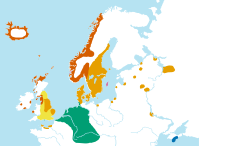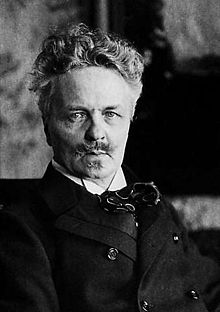
Danish is a North Germanic language from the Indo-European language family spoken by about six million people, principally in and around Denmark. Communities of Danish speakers are also found in Greenland, the Faroe Islands, and the northern German region of Southern Schleswig, where it has minority language status. Minor Danish-speaking communities are also found in Norway, Sweden, the United States, Canada, Brazil, and Argentina.
Faroese is a North Germanic language spoken as a first language by about 69,000 Faroe Islanders, of which 21,000 reside mainly in Denmark and elsewhere.

The Germanic languages are a branch of the Indo-European language family spoken natively by a population of about 515 million people mainly in Europe, North America, Oceania, and Southern Africa. The most widely spoken Germanic language, English, is also the world's most widely spoken language with an estimated 2 billion speakers. All Germanic languages are derived from Proto-Germanic, spoken in Iron Age Scandinavia, Iron Age Northern Germany and along the North Sea and Baltic coasts.

Norwegian is a North Germanic language from the Indo-European language family spoken mainly in Norway, where it is an official language. Along with Swedish and Danish, Norwegian forms a dialect continuum of more or less mutually intelligible local and regional varieties; some Norwegian and Swedish dialects, in particular, are very close. These Scandinavian languages, together with Faroese and Icelandic as well as some extinct languages, constitute the North Germanic languages. Faroese and Icelandic are not mutually intelligible with Norwegian in their spoken form because continental Scandinavian has diverged from them. While the two Germanic languages with the greatest numbers of speakers, English and German, have close similarities with Norwegian, neither is mutually intelligible with it. Norwegian is a descendant of Old Norse, the common language of the Germanic peoples living in Scandinavia during the Viking Age.

Old Norse, also referred to as Old Nordic, or Old Scandinavian was a stage of development of North Germanic dialects before their final divergence into separate Nordic languages. Old Norse was spoken by inhabitants of Scandinavia and their overseas settlements and chronologically coincides with the Viking Age, the Christianization of Scandinavia, and the consolidation of Scandinavian kingdoms from about the 8th to the 15th centuries.
Old English, or Anglo-Saxon, was the earliest recorded form of the English language, spoken in England and southern and eastern Scotland in the early Middle Ages. It developed from the languages brought to Great Britain by Anglo-Saxon settlers in the mid-5th century, and the first Old English literary works date from the mid-7th century. After the Norman Conquest of 1066, English was replaced for several centuries by Anglo-Norman as the language of the upper classes. This is regarded as marking the end of the Old English era, since during the subsequent period the English language was heavily influenced by Anglo-Norman, developing into what is now known as Middle English in England and Early Scots in Scotland.

Swedish is a North Germanic language from the Indo-European language family, spoken predominantly in Sweden and parts of Finland. It has at least 10 million native speakers, making it the fourth most spoken Germanic language, and the first among its type in the Nordic countries overall.
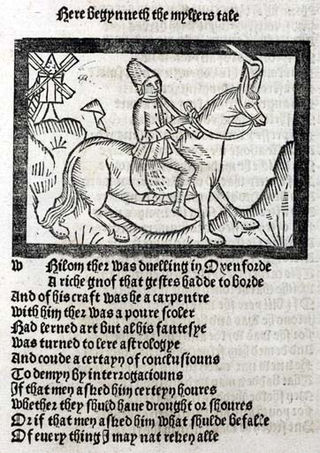
Middle English is a form of the English language that was spoken after the Norman Conquest of 1066, until the late 15th century. The English language underwent distinct variations and developments following the Old English period. Scholarly opinion varies, but the University of Valencia states the period when Middle English was spoken as being from 1150 to 1500. This stage of the development of the English language roughly followed the High to the Late Middle Ages.
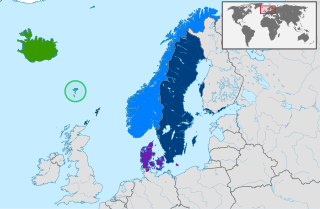
The North Germanic languages make up one of the three branches of the Germanic languages—a sub-family of the Indo-European languages—along with the West Germanic languages and the extinct East Germanic languages. The language group is also referred to as the Nordic languages, a direct translation of the most common term used among Danish, Faroese, Icelandic, Norwegian, and Swedish scholars and people.

Æ is a character formed from the letters a and e, originally a ligature representing the Latin diphthong ae. It has been promoted to the status of a letter in some languages, including Danish, Norwegian, Icelandic, and Faroese. It was also used in Old Swedish before being changed to ä. The modern International Phonetic Alphabet uses it to represent the near-open front unrounded vowel. Diacritic variants include Ǣ/ǣ, Ǽ/ǽ, Æ̀/æ̀, Æ̂/æ̂ and Æ̃/æ̃.

The letter Å represents various sounds in several languages. It is a separate letter in Danish, Swedish, Norwegian, Finnish, North Frisian, Low Saxon, Transylvanian Saxon, Walloon, Chamorro, Lule Sami, Pite Sami, Skolt Sami, Southern Sami, Ume Sami, Pamirian languages, and Greenlandic alphabets. Additionally, it is part of the alphabets used for some Alemannic and Austro-Bavarian dialects of German.
The orthography of the Old Norse language was diverse, being written in both Runic and Latin alphabets, with many spelling conventions, variant letterforms, and unique letters and signs. In modern times, scholars established a standardized spelling for the language. When Old Norse names are used in texts in other languages, modifications to this spelling are often made. In particular, the names of Old Norse mythological figures often have several different spellings.
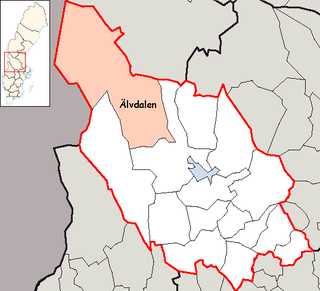
Elfdalian or Övdalian is a North Germanic language spoken by up to 3,000 people who live or have grown up in the locality of Älvdalen, which is located in the southeastern part of Älvdalen Municipality in northern Dalarna, Sweden.

Danish, Norwegian and Swedish are all descended from Old Norse, the common ancestor of all North Germanic languages spoken today. Thus, they are closely related, and largely mutually intelligible, particularly in their standard varieties. The largest differences are found in pronunciation and language-specific vocabulary, which may hinder mutual intelligibility to some extent in some dialects. All dialects of Danish, Norwegian and Swedish form a dialect continuum within a wider North Germanic dialect continuum.
Proto-Norse was an Indo-European language spoken in Scandinavia that is thought to have evolved as a northern dialect of Proto-Germanic in the first centuries CE. It is the earliest stage of a characteristically North Germanic language, and the language attested in the oldest Scandinavian Elder Futhark inscriptions, spoken from around the 2nd to the 8th centuries CE. It evolved into the dialects of Old Norse at the beginning of the Viking Age around 800 CE, which later themselves evolved into the modern North Germanic languages.
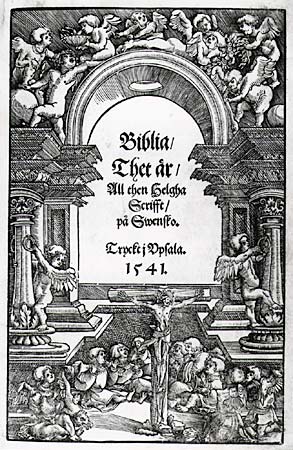
Modern Swedish is the linguistic term used for the Swedish language from the Bible translation of 1526 to the development of a common national language around 1880. The period can further be divided into Early Modern Swedish (1526–1750) and Late Modern Swedish (1750–1880).
Old Swedish is the name for two distinct stages of the Swedish language that were spoken in the Middle Ages: Early Old Swedish, spoken from about 1225 until about 1375, and Late Old Swedish, spoken from about 1375 until about 1526.

The Danish language developed during the Middle Ages out of Old East Norse, the common predecessor of Danish and Swedish. It was a late form of common Old Norse. The Danish philologist Johannes Brøndum-Nielsen divided the history of Danish into "Old Danish" from 800 AD to 1525 and "Modern Danish" from 1525 and onwards. He subdivided Old Danish into "Runic Danish" (800–1100), Early Middle Danish (1100–1350) and Late Middle Danish (1350–1525).

The history of the Icelandic language began in the 9th century when the settlement of Iceland, mostly by Norwegians, brought a dialect of Old Norse to the island.

Finnish is a Finnic language of the Uralic language family, spoken by the majority of the population in Finland and by ethnic Finns outside of Finland. Finnish is one of the two official languages of Finland, alongside Swedish. In Sweden, both Finnish and Meänkieli are official minority languages. Kven, which like Meänkieli is mutually intelligible with Finnish, is spoken in the Norwegian counties of Troms and Finnmark by a minority of Finnish descent.
